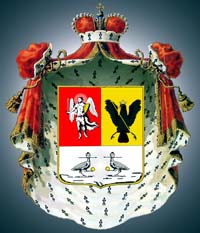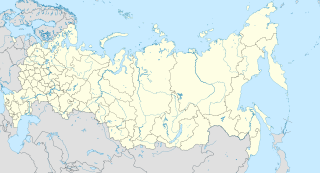This page is based on this
Wikipedia article Text is available under the
CC BY-SA 4.0 license; additional terms may apply.
Images, videos and audio are available under their respective licenses.

The Ingrian War between Sweden and Russia, which lasted between 1610 and 1617 and can be seen as part of Russia's Time of Troubles, is mainly remembered for the attempt to put a Swedish duke on the Russian throne. It ended with a large Swedish territorial gain in the Treaty of Stolbovo, which laid an important foundation to Sweden's Age of Greatness.

Tsarevich Dmitry or Dmitri Ivanovich, also known as Dmitry of Uglich or Dmitry of Moscow, was a Russian tsarevich famously impersonated by a series of pretenders after the death of his father Ivan the Terrible.

Vasili IV of Russia was Tsar of Russia between 1606 and 1610 after the murder of False Dmitriy I. His reign fell during the Time of Troubles. He was the only member of House of Shuysky to become Tsar and the last member of the Rurikid dynasty to rule.

The De la Gardie Campaign refers to the actions of a 5,000-strong Swedish auxiliary corps, commanded by Jacob De la Gardie and Evert Horn in alliance with the Russian commander Mikhail Skopin-Shuisky against False Dmitry II and Polish–Lithuanian Commonwealth in the Polish–Muscovite War (1605–18).
Prince Alexander Borisovich Gorbatyi-Shuisky was probably the most celebrated and popular general of Ivan the Terrible. The town of Gorbatov in Nizhny Novgorod Oblast bears his name.
Vorotynsky was one of the most eminent Rurikid princely houses of Muscovite Russia. Their lands lay principally in the Upper Oka region and comprised the towns of Peremyshl and Vorotynsk as well as parts (дольницы) of Novosil and Odoyev.
The Belsky or Belski family was a princely family of Gediminid origin in the Grand Duchy of Lithuania. It later deflected to the Grand Duchy of Moscow and played a key role during the regency of Ivan IV of Russia. The family started with Ivan Vladimirovich, son of Vladimir Olgerdovich and grandson of Algirdas, and ended with Ivan Dmitrievich Belsky in 1571. The Belsky name was derived from their principal possession of Bely, Tver Oblast.
Nikita Romanovich, also known as Nikita Romanovich Zakharyin-Yuriev, was a prominent boyar of the Tsardom of Russia. His grandson Michael I founded the Romanov dynasty of Russian tsars.
Buturlin was a Russian noble family. Notable members of the family include:

Repnin, the name of an old Russian princely family of Rurikid stock. The family traces its name to Prince Ivan Mikhailovich Obolensky (+1523), nicknamed Repnya, i.e., "bad porridge". Like other princes Obolensky, he descended from Mikhail Vsevolodovich, prince of Chernigov, who, in 1246, was assassinated by the Mongols.
The Seven Boyars were a group of Russian nobles who deposed Tsar Vasily Shuisky on 17 July 1610 and, later that year, invited the Poles into Moscow.

Mezhdurechensky District is an administrative and municipal district (raion), one of the twenty-six in Vologda Oblast, Russia. It is located in the center of the oblast and borders with Sokolsky District in the north, Totemsky District in the northeast, Soligalichsky District of Kostroma Oblast in the southeast, Gryazovetsky District in the south, and with Vologodsky District in the west. The area of the district is 3,600 square kilometers (1,400 sq mi). Its administrative center is the rural locality of Shuyskoye. District's population: 6,112 (2010 Census); 7,641 ; 9,361 (1989 Census). The population of Shuyskoye accounts for 36.8% of the district's total population. As of 2010, Mezhdurechensky District had the lowest population among all the districts of Vologda Oblast.

Shuyskoye is a rural locality and the administrative center of Mezhdurechensky District of Vologda Oblast, Russia, located on the right bank of the Sukhona River. It also serves as the administrative center of Sukhonsky Selsoviet, one of the eight selsoviets into which the district is administratively divided. Municipally, it is the administrative center of Sukhonskoye Rural Settlement. Population: 2,250 (2010 Census); 2,436 (2002 Census); 2,531 (1989 Census).

Shuysky tribute was the act of homage of the deposed Tsar Vasily IV of Russia and his retinue to the Polish King Sigismund III Vasa and teenage prince Władysław on October 29, 1611, in the Senate Hall of the Royal Castle in Warsaw.
Miloslavsky family was a Russian noble family. The Miloslavskys are mostly known for Maria Miloskavskaya who married Tsar Alexey Romanov.











